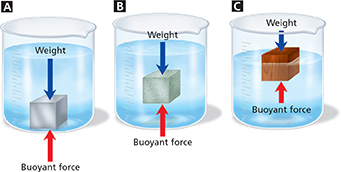Archimedes' Principle
Archimedes, an ancient Greek mathematician who died in 212 B.C., is credited with an important discovery that bears his name. According to Archimedes' principle, the buoyant force on an object is equal to the weight of the fluid displaced by the object.
When an object is submerged, it pushes aside, or displaces, a volume of fluid equal to its own volume. When an object floats on the surface of a fluid, it does not displace its entire volume. The floating object does, however, displace a volume equal to the volume of the part of the object that is submerged.
Density and Buoyancy
Density and buoyancy are closely related. Recall that density is the ratio of an object's mass to its volume. Densities are often expressed in the non-SI units of grams per cubic centimeter (g/cm3). Water, for example, has a density of 1 g/cm3, whereas steel has a density of 7.8 g/cm3.
 If an object is less dense than the fluid it is in, it will float. If the object is more dense than the fluid it is in, it will sink. Different fluids can also float or sink in one another. Oil, for example, floats on water because oil is less dense than water.
If an object is less dense than the fluid it is in, it will float. If the object is more dense than the fluid it is in, it will sink. Different fluids can also float or sink in one another. Oil, for example, floats on water because oil is less dense than water.
You can also determine if an object will float by analyzing the forces acting on it. As you can see in Figure 11, two forces act on every object in a fluid—weight and the buoyant force. The force of gravity, equal to the object's weight, acts downward on the object. The buoyant force, equal to the weight of the volume of displaced fluid, acts upward on the object.  When the buoyant force is equal to the weight, an object floats or is suspended. When the buoyant force is less than the weight, the object sinks.
When the buoyant force is equal to the weight, an object floats or is suspended. When the buoyant force is less than the weight, the object sinks.

Figure 11 The weight and buoyant force determines if an object sinks or floats. A The metal cube sinks because its weight is greater than the buoyant force. B Equal forces acting on this submerged cube allow it to be suspended in the fluid. C The partially submerged wood cube floats at a depth where the buoyant force and weight are equal.
Image spans to next page
Quick Lab
Changing Buoyancy
Procedure 
Fill a plastic bottle with water up to its neck. Squeeze a dropper pipet's bulb and draw water into the pipet until it is about half full. Insert the pipet, bulb end up, into the bottle. The pipet should float at the water's surface.
Add water to the bottle until it is full. Tightly twist the cap onto the bottle. Trap as little air as possible in the bottle.
Observe what happens to the pipet as you squeeze, hold, and then release the bottle.
Analyze and Conclude
Applying Concepts Describe the changes in pressure during Step 3.
Inferring How did the volume of the air trapped inside the pipet change when the bottle was squeezed?
Drawing Conclusions Explain how squeezing and releasing the bottle caused the pipet to move up and down in the water.




